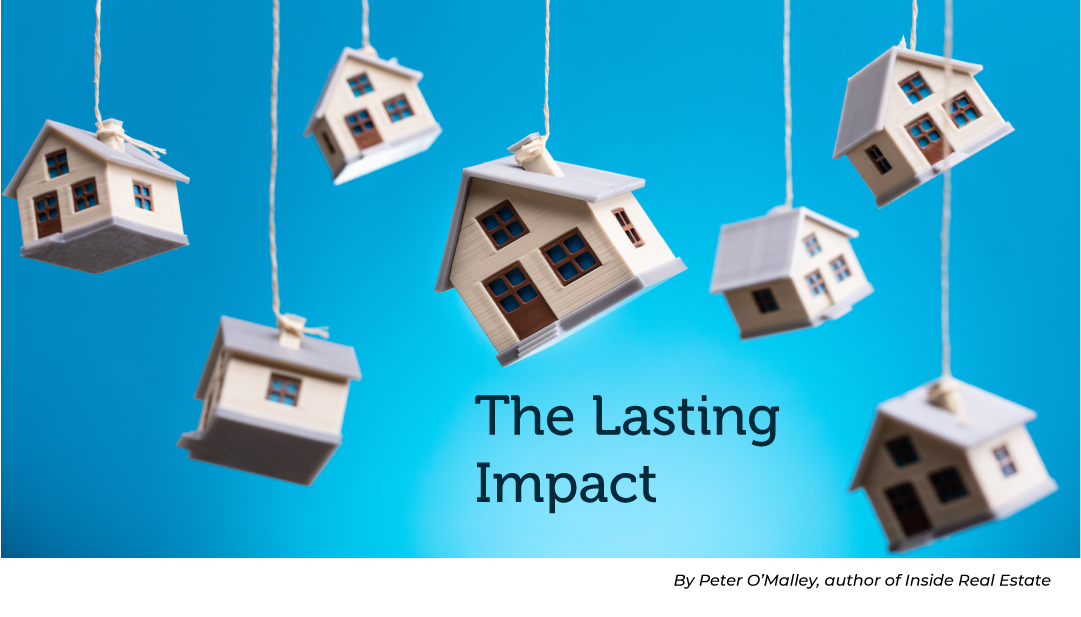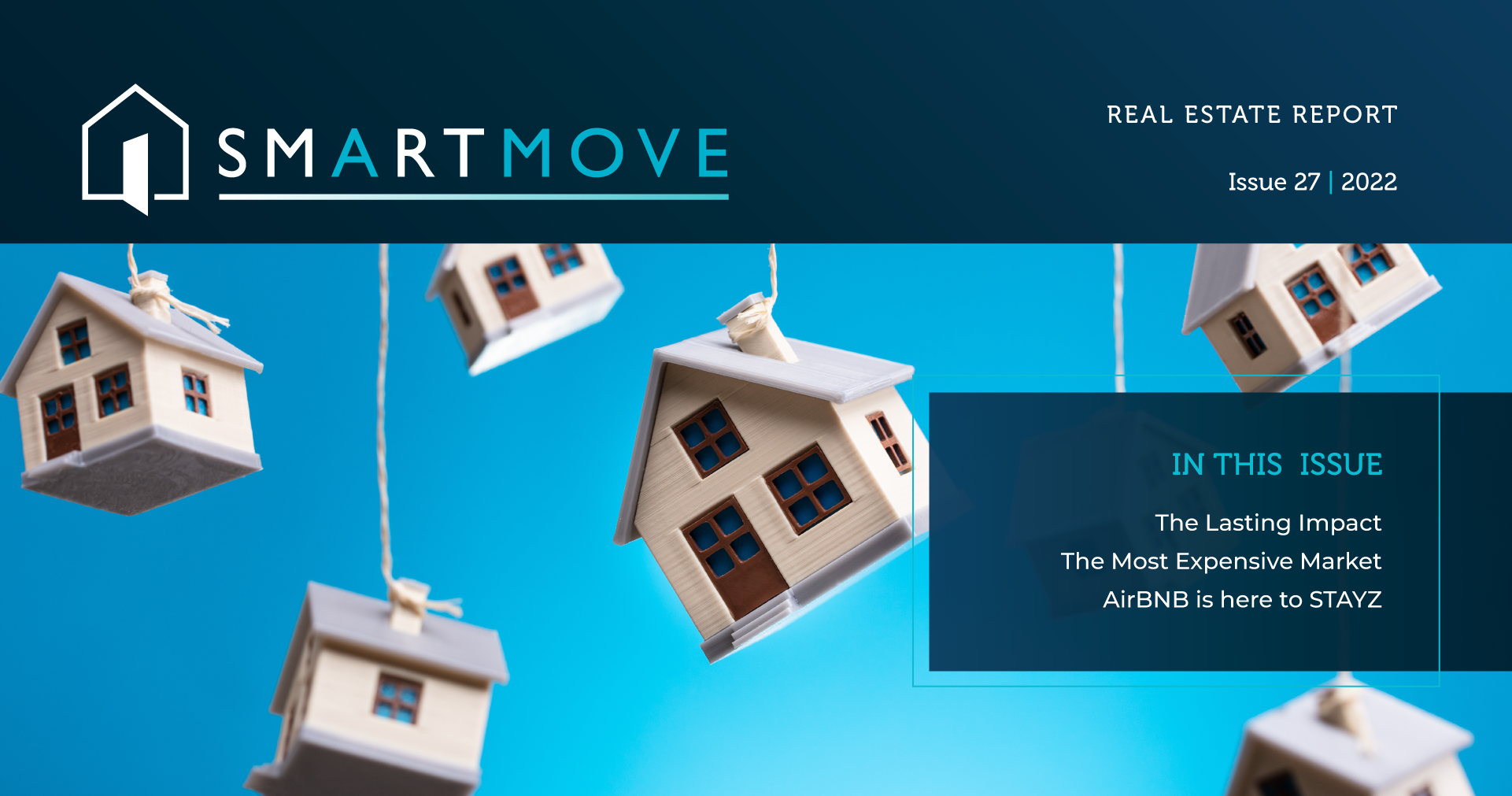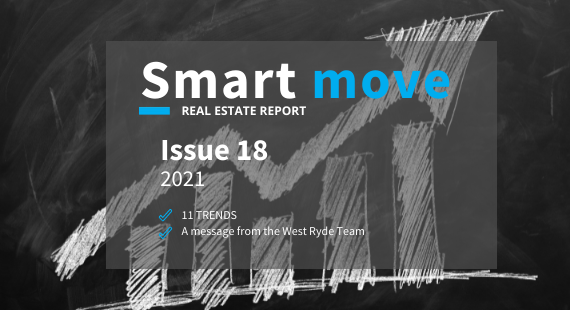Issue 27 - 2022

The end of COVID is near, thankfully. The lasting impact across society, the economy and the property market will be immense. Conversely, some of the trends that emerged during COVID in the property market will reverse themselves. Below we break down how demographics, lifestyles and market trends will combine to re-shape residential and commercial real estate.
Residential
‘Work from home’ (WFH) was triggered during COVID even though the capability to do so existed well before the pandemic arrived. The need to lock down and/or social distance drove employers to enable their teams to work remotely. Now that employers and employees have undertaken a two-year trial of WFH, the benefits for both parties have been immense and clear. Whilst there will be an inevitable ‘return to office’ (RTO) trend in 2022/23, for millions of employees around the world, they won’t be returning to the office fulltime. Another lasting impact is the employee’s workplace of the future is likely to be split between the home and office.
This will drive a multitude of changes in the residential sector. Developers will be catering to home office arrangements; spare bedrooms will be and have been converted into study spaces and families will find themselves upgrading to secure more space. Families pursued additional space during COVID to allow/ensure household harmony between parents who are WFH and their children.
The lasting impact in capital cities where people willingly sacrificed space for convenience to the CBD/workplace, reduced office days will mean they can now sacrifice convenience for space and move to a larger property further away from their workplace. Avoiding the daily grind of the commute to and from work is the key driver for many people who opt to WFH.
In Sydney, regions such as the Northern Beaches and the Shire outperformed the broader market given the lifestyle benefits on offer for those that can WFH. These trends in the residential sector are being replicated globally as the world transitions into a post pandemic world.
The household becoming a workplace was a secondary contributor to the sharp rise in property prices. Low interest rates and easy Government money swooshing around the economy kick started the party. Increasingly the need for a harmonious work and home arrangement saw many people upgrade during COVID when they otherwise would not have done so.
WFH is not for everyone and there will be just as many people looking to and/or need to RTO fulltime as there will be people looking to adopt the hybrid model of working from both home and the office.
In October 2021, it was reported employees at NIB one of Australia’s biggest private health insurers, would get paid $1,200 on top of their annual salary to stay at home, as the firm pivots into a post-Covid remote working model. NIB CEO Mark Fitzgibbon said the days of commuting into the office are ‘long gone’.
Regions
COVID inadvertently highlighted the appeal of living outside large cities in regional centres and towns that offered great infrastructure and lifestyle benefits. Regional locations within 90 minutes’ drive of capital cities seems to be the ideal distance for those abandoning city lifestyles. Think of Brisbane to the Sunshine Coast, the South Coast of NSW to Sydney or the Mornington Peninsula to Melbourne as prime examples of lifestyle markets that have boomed through COVID and will continue to perform well in the years ahead.
Check out this interview for more insights into the 2022 property market.
Office space
Just as the Government’s WFH mandates during COVID increased the appeal of a home office and in turn caused house prices to rise, it equally detracted from the need and appeal of commercial office space. If ever a business wanted to upgrade their office now is the time to do so given commercial rents have crashed. The sector has been under sustained pressure since COVID began. The ramifications will be felt for years ahead too.
Given the increase of people who will now WFH post pandemic, the office sector may never return to pre-pandemic levels. Governments and business will do their best to cajole people back to the workplace. Given the battle for talent being played out in many industries though, employers will find themselves acquiescing to the employee’s WFH request. Accommodating WFH preferences will be a key recruitment/retention tool post pandemic.
In turn, business will scale back, scale down if not close workplaces to reflect the needs of the post pandemic business model.
In March 2022 Nick Lenehan of the AFR wrote ‘The upheavals to business and work practices caused by the pandemic have added close to 500,000 square metres more vacant space to the major city markets than originally expected over the past two years, according to an industry analysis.’
The reality is office space will be devalued as desperate landlords slash the rents to attract tenants.

Retail
The pandemic forced many of us into internet shopping, to the detriment of our local retailers, who were essentially forced to close during lockdowns. Combined with the pre-pandemic trend toward larger retailers and cheaper online retailers, suburban retail strips around the world have been under pressure.
Defining exactly how retail will perform is challenging as the sector will experience ‘wins and losses’ in the post pandemic world. If WFH remains a powerful trend, the business lost around CBD retail stores could be picked up on suburban shopping strips. For example, an employee that buys two coffees a day in the CBD may WFH and buy those two coffees from their local barista instead. In such circumstances the business has not evaporated from the retail sector, it has moved locations.
Conversely, business is lost in the retail sector when someone purchases a pair of 10.5 Nike Air Max on Amazon rather than at their local sports store. The business lost to the internet is never recovered by smaller retailers. Over the past 20 years, internet shopping has eroded the value of retail premises and that downturn has only accelerated during COVID.
Industrial
The rise of internet shopping has seen value drift out of the retail sector and into the industrial/storage space. COVID may continue to move around the community for years to come. The vulnerable will understandably continue to avoid unnecessary contact and stick with internet shopping delivered to the front door.
This somewhat unfortunate trend makes industrial warehousing a prime real estate market in the next decade.
There will be many disruptive side effects as a result of COVID that will have a lasting impact on the overall real estate market. Expect to see real estate values both rise and fall across different sectors of the industry.

A lot is made of how expensive the Sydney property market has become in comparison with global peers. There is a second market that Sydney is a world leader in when it comes to expensive – real estate internet advertising. Homeowners pay more to market their homes on the internet in Sydney and Australia, broadly speaking, than just about anywhere else in the world.
In the days of newspapers, agents became addicted to a model called VPA. That’s Vendor Paid Advertising. The agent convinced the client to spend excessive amounts of money on advertising their home, using the ‘old chestnut’, more advertising equals a higher price.
Homesellers collectively ‘invested millions of dollars’ each year thinking they were selling their home when they were actually buying needless advertising. The seller inadvertently paid to build the agent’s profile and branding in the community.
Then the internet became the dominant marketing tool and essentially wiped newspaper advertising out. Now everything old is new again as VPA has returned with a vengeance and a digital veneer. Agents are now looking to outspend each other on the internet with bigger ads at the owner’s expense. That would be fine if the homeseller and agent gained a joint benefit from all this advertising. Alas, homebuyers are interested in the property not the size of the advertisement.
Real estate advertising expenditure has exploded in the past 20 years from nothing to billon dollar companies. Some individual ads cost as much as $2500. On a global scale, this puts Aussie home sellers at the top of the heap when it comes to outlay for real estate advertising on the internet. One stockbroker made insightful comments prior to the release of recent Domain results. The firm was looking for ‘any indication that real estate agents were beginning to resist price increases’ from Domain.
While everyone is asking, how high can house prices go? Others are asking, how high can these advertising rates go?
Agents may be showing subtle signs of stress at the price increases. Off market transactions are increasing as agents aim to use their database more effectively as opposed to upselling their clients on excessive VPA. Neither consumers or agents are showing an appetite for annual price increases three times the rate of inflation.
Opportunists sense the gap in the market too. This is why your television and radio are awash with discount agents and referral firms promising the ‘same for less’ as full-service realtors.
If an agent, asks you to spend $10,000 on a campaign ensure they justify the expense. If expensive internet advertising is such good value, let the real estate agent pay. They’re the party getting the most benefit from it.

During the pandemic, Short Stay Rental Accommodation (STRA) in capital cities all but disappeared as landlords moved their investment properties across to the permanent letting market. The additional dwelling supply that moved across to the long term rental pool in early 2020 exacerbated the downturn in capital cities, as rental markets were already suffering from oversupply at a time of diminishing tenancy demand.
At the same time, STRA boomed in the regions as Australians holidayed domestically given the International (and many state) borders were closed.
Understandably, landlords in capital cities are relieved the international borders are now open and hopeful the rental market returns to normality. International students will be the main driver of the rebound. If international business travellers, tourists and back packers can be enticed to Australia, STRA will jump in popularity. The supply in STRA would be driven by landlords re-purposing their long term investment properties across to the likes of AirBNB and/or Stayz.
As rental dwelling supply is absorbed at a time that demand increases, the dynamics of the rental market will begin to change quite quickly. In such a scenario, it would be reasonable to expect a sharp tightening in the rental market vacancy rate – a sure sign rents are set to jump.
During the pandemic, subtle changes were made to the legislation surrounding STRA, particularly for apartments. Landlords looking to enter the STRA space are well advised to familiarise themselves with the new policy.
From 1 November 2021, most hosts must register their STRA premises on the Department of Planning, Industry and Environment’s STRA register. Relevant properties must be registered before they can be advertised or offered for short-term rental. There are fees associated with registration.
New planning laws were introduced in November 2021, including a new planning policy that applies consistent regulation of the use of premises for short-term rental accommodation across the whole state of NSW.
Jimmy Thomson of Flat Chat podcast recently wrote in the Financial Review “apartment owners who think their apartment blocks have locked out short term rental accommodation could be in for a shock” under the new legislation.
An occupant (owner or tenant) still reserves the right to put their principal place of residence into the STRA market, for a maximum 180 nights per year.
For example, a tenant who decides to go away for a month can lease their apartment on AirBNB or an owner occupier can head to Europe for winter and lease their home out on Stayz. Strata By Laws cannot prohibit STRA in either of these examples.
However, an apartment investor cannot lease their apartment by way of STRA – if it conflicts with the building’s Strata Bylaws.
In blunt terms, a tenant can sub-lease the apartment out for 26 weeks a year, but the landlord who owns the apartment is forbidden from doing so.
These new measures have not really been practically stress tested given the COVID shutdowns to date. That’s all about to change though as policy meets reality.



